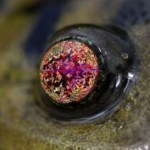retina
What does a tiny patch of salamander retina see when it watches a movie? Weizmann Institute scientists, together with Dr. Ronen Segev at Ben-Gurion University, performed this experiment - literally showing film sequences to snippets of live retina tissue and recording the interactions between their 100 or so active neurons.
Seeing, as we know, is 3/4 interpretation and, contrary to common belief, this interpretation begins in the eye, before an image ever reaches the brain. Dr. Elad Schneidman and his colleagues found that unique patterns of neuron activity could be identified: There were…
DEPRESSION has long been associated with vision - and to colour perception in particular - and the link between them is evident in everyday language. Depression is, of course, often referred to as "feeling blue", and those who suffer from it are sometimes told to "lighten up". The link can be found in art, too - Picasso's so-called "Blue Period", for example, which was brought on by the suicide of his close friend Carlos Casagemas, is characterised by a series of striking paintings in shades of cold blue, which express the deep melancholy he felt at the time.
Although the association between…
THE retina has an inverted structure which seems ill-suited to its function: the rod and cone cells, which are sensitive to light, and which convert light energy into electrical impulses, point backwards and are located at the back of the retina, so that light entering the eye has to pass through several layers of irregularly organized cells before it reaches them. The retina also contains nerve fibres which are positioned perpendicular to the path of light entering the eye, and many of the structures in the upper cell layers have a diameter similar to that of the wavelength of visible light…
In the forests of South America lives the unusual but aptly named owl monkey, or douroucouli. You could probably guess by looking at its large round eyes that it's nocturnal, and indeed, it is the only monkey to be mostly active at night. But its eyes have many adaptations for such a lifestyle, beyond a large size.
The owl monkey's retinas are 50% larger than those of a day-living monkey of similar size, like the brown capuchin. The proportions of different cells in their retina are also different. Owl monkeys have relatively few cone cells, which are responsible for colour vision and fewer…
Nocturnal animals face an obvious challenge: collecting enough light to see clearly in the dark. We know about many of their tricks. They have bigger eyes and wider pupils. They have a reflective layer behind their retina called the tapetum, which reflects any light that passes through back onto it. Their retinas are loaded with rod cells, which are more light-sensitive than the cone cells that allow for colour vision.
But they also have another, far less obvious adaptation - their rod cells pack their DNA in a special way that turns the nucleus of each cell into a light-collecting lens.…
In the twilit waters of the deep ocean, beneath about 1000m of water, swims the brownsnout spookfish (Dolichopteryx longipes). Like many other deep-sea fish, the spookfish is adapted to make the most of what little light penetrates to these depths, but it does so with some of the strangest eyes in the animal kingdom.
For a start, each eye is split into two connected parts, so the animal looks like it actually has four. One half points upwards and gives the spookfish a view of the ocean above. The other points downwards into the abyss below and it's this half that makes the spookfish unique.…
